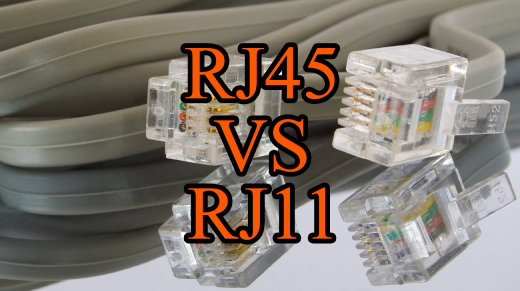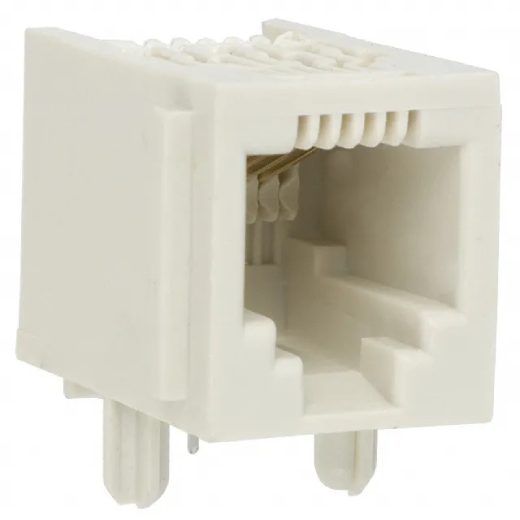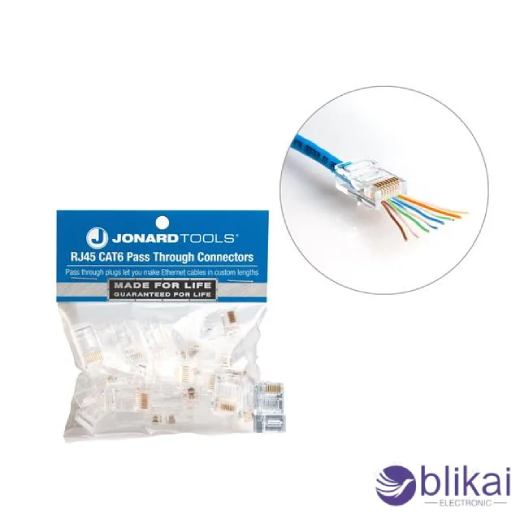RJ45 vs RJ11: What's the Main Differences? (Guide)
As far as plastic connectors for communication cables are concerned, RJ11 and RJ45 are very similar. The RJ45 standard is used for Ethernet cables such as Cat5 and Cat5e, while the RJ11 standard is used for telephone lines such as PRI and FTTC. Registered jacks are abbreviated as "RJ". Many people refer to RJ11 as a phone jack. In this blog, we will examine connectors of communication cable types other than RJ11 and RJ45.

What is an RJ11 Cable Connector?

It is primarily used for terminating telephone wires since it is compact, modular, and uses a single crimp. There are six positions on the connector, and it accepts two wires (6P2C), although typically only two wires are used for telephone applications. Connecting analog telephones with wall outlets using RJ11 connectors is widely known as a method of enabling voice communication over analog lines. Connectors for telephone lines and modems are also commonly used for data communication. In telecommunications and some networking setups, RJ11 connectors are one of the most important components because of their small size and standardization.
What is an RJ45 Cable Connector?

Ethernet network devices, such as computers, routers, switches, and other network devices, can be connected with an RJ45 cable connector. A twisted-pair connector (8P8C) houses eight wires with eight positions, which allows data to be transmitted over twisted pairs. Cat5e and Cat6 cables use RJ45 connectors, which can support multiple network speeds, including gigabit Ethernet. A rectangular connector with a clip ensures a stable connection within a network port due to its rectangular shape and clip. With reliable and high-speed data transfer capabilities, RJ45 connectors are common in both home and enterprise networks.
RJ45 vs RJ11: Main Differences
Physical Size and Shape
-
RJ45: In a rectangular shape with eight positions and eight conductors (8P8C), the device is larger and more rectangular in shape. As a result, it is suited to Ethernet networking since it can accommodate up to eight wires.
-
RJ11: In this configuration, there are six positions, two conductors (6P2C), though only two or four of these are usually used. Thus, it can be used to connect to telephone lines.
Number of Conductors
-
RJ45: The cable has eight conductors that allow it to be used in data communication networks to transfer data faster and with higher bandwidth.
-
RJ11: In its primary role as a voice communication over telephone lines, it usually uses two or four of the six available conductor positions.
Primary Uses
-
RJ45: Computers, routers, switches, and other network devices are frequently connected with Ethernet cables in networking applications. Gigabit Ethernet is supported as well as other network speeds.
-
RJ11: Phone connections, such as landlines, modems, and fax machines, are primarily made using modems. A voice communication signal is handled by it.
Compatibility
-
RJ45: With Cat5, Cat5e, and Cat6 cable compatibility, it is versatile for various network infrastructure types.
-
RJ11: Low-speed data communication cables and telephone cables are compatible.
Data Transmission Capacity
-
RJ45: With the right cable type, you can transmit data at up to 10Gbps (e.g., Cat6a).
-
RJ11: This system is designed for low-speed voice communication and analog voice signals.
Connector Locking Mechanism
-
Both RJ45 and RJ11: Plastic clips ensure a secure connection by locking the connector into the socket. Despite their size differences, the RJ45 clips are larger and sturdier because of their size differences.
Applications
RJ45 Connectors
Ethernet Networking: LANs are primarily connected through RJ45 connectors, the key to Ethernet networking. Data is transferred efficiently and reliably between computers, servers, routers, and switches using these connectors. The RJ45 connector ensures high-speed communication when using Cat6a or higher cables for gigabit Ethernet applications, which support speeds up to 1 Gbps and beyond. In both residential and commercial networking environments, they are indispensable due to their robust design and standard pin configuration.
Telecommunication: Voice over Internet Protocol (VoIP) systems require RJ45 connectors in the realm of telecommunications. Instead of using traditional phone lines for voice communication, these systems convert analog voice signals into digital packets. Computer networks are easily integrated with VoIP phones, IP-based PBX systems, and network interface devices that use RJ45 connectors. By integrating these systems, modern communication systems are more efficient and flexible, resulting in cost-effective and scalable solutions for businesses and individuals.
Home Networking: In home networking, particularly in home offices, RJ45 connectors are vital. The home network provides a stable and high-speed internet connection for devices like computers, printers, and smart home gadgets. In order to work remotely, learn online, and enjoy entertainment, this type of connectivity is vital. Moreover, RJ45 connectors enable seamless sharing and streaming of digital content across multiple household devices, including network-attached storage (NAS) devices and media servers.
Industrial and Commercial Applications: Automated systems, security systems, and industrial Ethernet networks use RJ45 connectors in commercial and industrial settings. A PLC, sensor, or other device that communicates and controls data in real-time can be connected to a network via one of these devices. Network video recorders (NVRs) and IP cameras are connected by RJ45 connectors in security systems, providing reliable video transmission. These demanding applications benefit from their durability and ability to handle high data rates.
Data Centers: A large percentage of high-speed and high-density network connections in data centers are established via RJ45 connectors. Data can be transferred and processed rapidly thanks to these devices, which connect servers, storage devices, and network switches. Structured cabling systems use RJ45 connectors in these environments to efficiently manage and organize the complex network infrastructure. In order to meet the growing demands for bandwidth and performance, data centers need to support advanced Ethernet standards.
RJ11 Connectors
Landline Telephones: Landline telephone systems are most commonly equipped with RJ11 connectors. Connectors such as these enable telephones to communicate over analog telephone lines. Residential and office phone installations rely on their simple design and reliable connection. Due to its compact size, RJ11s can be easily installed and maintained in traditional phone bases and wall jacks.
DSL Modems: During the implementation of Digital Subscriber Line (DSL) services, RJ11 connectors play a crucial role. Internet access over telephone lines is provided by DSL modems using RJ11 connectors. Using RJ11 connectors simultaneously enables users to browse the internet and make phone calls, allowing them to carry out both tasks simultaneously. Internet setups for small businesses and homes need this dual functionality.
Fax Machines: A fax machine sends and receives documents using RJ11 connectors over telephone lines. Fax machines communicate with each other through RJ11 connectors connected to the phone line. Many business environments require this setup for fast and efficient document transmission. In industries that require secure and reliable document transmission, fax machines and RJ11 connectors continue to be used despite the rise of digital communications.
Modems and Dial-Up Internet: The RJ11 connector was indispensable when dial-up internet was available. Computers could access the internet by connecting modems to telephone lines. There are still some rural or remote areas that do not have access to high-speed internet, even though dial-up has been largely replaced by broadband and fiber optic connections. For basic internet connectivity in these locations, RJ11 is a practical solution since it is compatible with telephone lines.
PBX Systems: Internal telephone networks within organizations are managed by PBX systems, which use RJ11 connectors extensively. Multi-line PBX systems combine internal and external phone lines to optimize communication within a company. PBX systems are connected to each phone using RJ11 connectors, enabling effective call routing. Business networks that require robust communication are in need of this application.
Advantages and Disadvantages
The maximum speed supported by RJ45 connectors surpasses traditional POTS and even digital subscriber lines. A quality cabling plant is capable of delivering gigabit and 10GbE performance. A larger connector footprint, however, requires more material and labor during installation for greater capabilities. Component costs and infrastructure expenses are also higher for certified channels.
Legacy telephony applications continue to benefit from RJ11's lower cost and compact size. The bandwidth is limited to around 1Mbps, so symmetric broadband internet can't be supported. Technical needs are balanced with associated costs when choosing connector types. As network demands increase, RJ45 becomes more practical in situations without advanced data requirements, whereas RJ11 is better suited for analog voice applications.
Final Verdict
The purpose and capabilities of RJ45 and RJ11 connectors need to be understood when choosing between them. Computers, routers, switches, and router connectors are commonly used with RJ45 connectors to connect to Ethernet networks, which support high-speed data transfer. For enhanced data communication, they are designed with eight positions and eight conductors (8P8C).
RJ11 connectors, on the other hand, are used for low-speed data and telephone applications. Landline telephones, DSL modems, fax machines, and other analog devices can be connected to them with their smaller 6-position, 2-conductor (6P2C) setup. In contrast to modern high-speed networking needs, RJ11 connectors have fewer conductors, limiting them to lower bandwidth applications.
Therefore, RJ45 connectors are best suited for networking and transferring digital data quickly, while RJ11 connectors are best suited for transferring low-speed data and traditional telephone systems.
Related Articles
RJ45 Color Code: All You Need to Know (Guide)
RJ45 Connector: Everything You Need To Know (Guide)
Mastering RJ45 Connectors: A Comprehensive Handbook
Isolator vs Switch Disconnector: What's the Main Differences?
What is a DB9 Connector? (Everything Explained)
What do Microminiature and Ultraminiature RF connectors entail?
What Is Network Interface Card: Applications and Functions
What are Wireless Sensor Networks : All Explained
Networking Solution: Everything You Need to Know
D-Sub Cables: Types, Applications & Advantages
Modular Cables: Types, Advantages & Applications
What is Firewire Cables? All Explained
The Power of RG11 Coaxial Cable: Advantages and Applications
Varieties of Monitor Cables: A Beginner's Guide
Varieties of Electrical Wires and Cables
How to Charge Capacitor Without Resistor?










